That Was Shocking.
I’ve been posting on this substack for a few weeks, and it’s been going very well. But it suddenly took a turn for the Even Better, when Tuesday I wrote about Monasukapanough. (That’s the Monacan town that for seven centuries lay north of Charlottesville.) In two days I had as many views, shares, and subscribers as I’d had the previous two weeks.
That’s entirely due to how interesting Monasukapanough and the Monacans are, and has little to do with me, but since there seems to be a lot of interest out there, I wanted to float an idea. (Don’t worry; it’s not a fundraiser.) Let me know if you think it’s worthwhile!
I’d love it if kids googling information on Native American settlements for a school report, or adults who are googling because they’re curious, could find pictures of Monacan towns online. And I’d love it if people of in the area could get a sense of what Monasukapanough looked like. The Monacan Indian Nation used to keep a living history exhibit at Natural Bridge, but in order to staff it with historical interpreters it focused on the crafts and constructions techniques and couldn’t possibly recreate a whole town. And anyway when it became a state park, the village was no more.
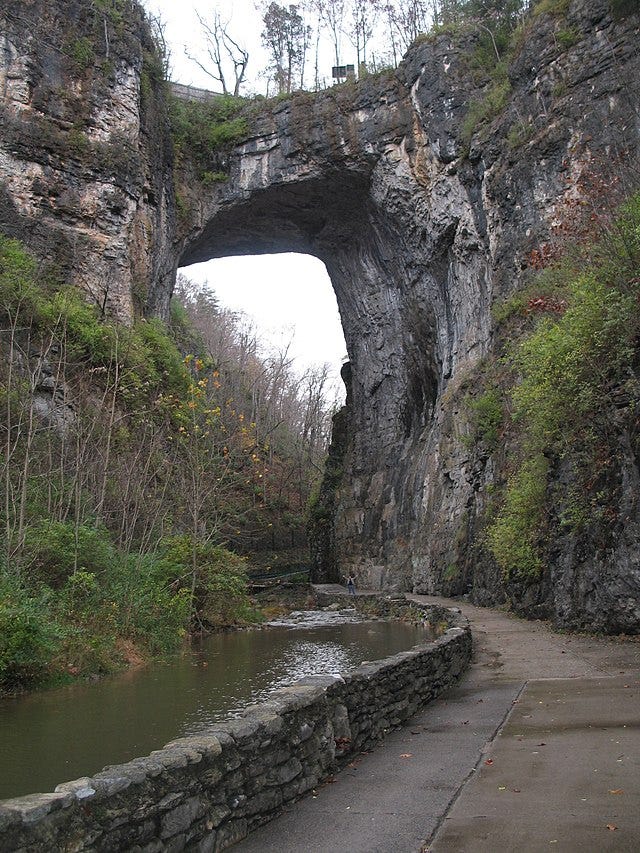

Why Not Build It Small?
So I’d like there to be a diorama of Monasukapanough, and to have photos taken of the diorama and shared on WikiCommons and other public domain platforms so kids doing school projects, or anyone just curious, would get to see realistic images. Then I’d like the diorama to be on display somewhere in the area so people can see it, and then it would be donated it to the Monacan Museum.
A picture is worth a thousand words!
My brother Bret Jones runs a hobby store and they build beautiful dioramas. (They have layouts in the Museum of the American Revolution in Philadelphia
and The Quarry Gardens in Schuyler, plus you can see a layout in the lobby of the Graduate Hotel, I think.) We have some funding. His store could build a model of Monasukapanough, we’d get photographers to take public domain photos to put online, we’d display it on loan somewhere in Charlottesville and/or Albemarle for a year or so, and then we’d donate it to the Monacan museum (if they wanted it).
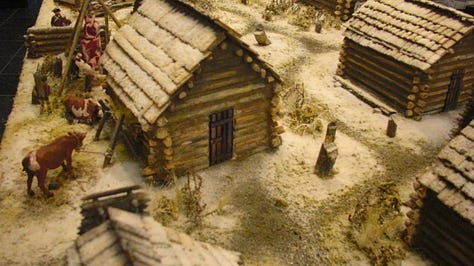
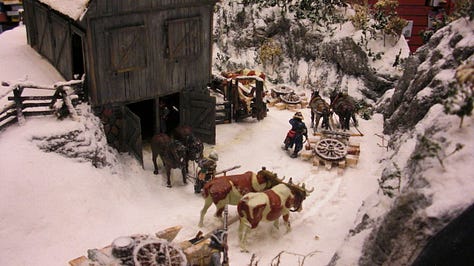
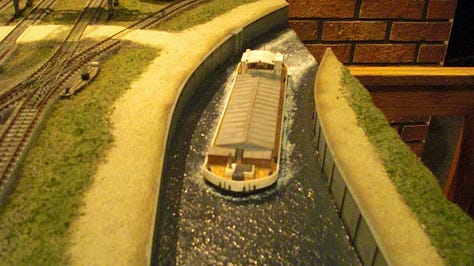
Bret and I were in the brainstorming stage of doing exactly this during Covid when my theater company was shut down. I’d been in contact with the Museum and emailed Jeffrey Hantman, the UVa archaeologist who wrote the book I cited, and they both approved; but then paying work picked up (after so many months of no income), and I had no sense that anyone would be interested in something like this. Is it just my nerd-world? Is the project worth resurrecting? If so, where would you want it displayed? Library, historical society, visitor’s center, city hall? Anyone out there have opinions or contacts? (Especially contacts.) We had some money pledged from before, so we don’t need money! What we need is ideas such as…
Where do we put it?
Does anyone have contacts at someplace that might want a diorama on loan for a year?
Please share if you know anyone who could help with the project:
John White & the Algonquian Legacy
Meanwhile if you ever try to research Native American anything, especially regarding the Eastern Seaboard, you’re likely to come across images like these:
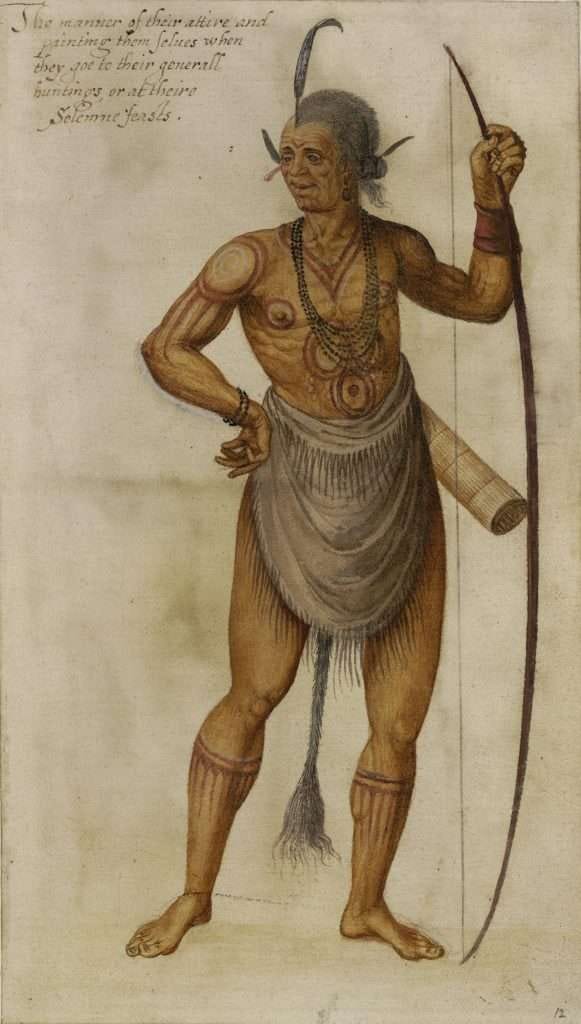

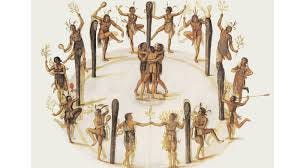

They’re watercolors of the Secotan people by a guy name John White. He was governor of the famous ‘Lost Colony’ on Roanoke Island, though he didn’t get lost when they did. The illustrations mostly come from an earlier expedition in the same area in which he was working for Sir Ralph Lane. They brought an expert team with a metalurgist, botanist, mathmetician (to act as a surveyor), and an illustrator (White), but after some setbacks they returned to England in 1586. It’s an amusing irony of history that the North Carolina settlements in general were well-organized projects whose leaders genuinely cared about their people while Jamestown in Virginia was a chaotic mess thrown together by a greedy corporation who let 4/5 of their colonists die in the first couple years.
Guess which settlement survived?!

Anyway, Sir Walter Raleigh authorized a new expedition to be led by White himself as the official governor. It would include families for a permanent town. White convinced his daughter and son-in-law to go, Eleanor and Ananias Dare. They all sailed in 1587. They were supposed to land in the Chesapeake but got dumped back in the Outer Banks instead. White’s granddaughter Virginia Dare was born later in the summer but that’s about the only thing that went right. Maybe in John White’s entire adult life. Worried that their changed location might deny them supply ships, White was sent back to bring supplies himself.
He made it back to England to discover a war with Spain so no ships could be spared. Finally, after the Spanish Armada was defeated in 1588 White was able to put together a couple of ships. Unfortunately, no sooner where they at sea then they were attacked by French pirates and White was shot in the butt. So he had to go back to England for his butt to heal and to replace the supplies the pirates looted. There was a further delay because of further troubles with Spain. But finally in 1590 White scrounged up yet another couple of ships, and after yet more setbacks including storms that cost the flotilla three anchors, they made it to Roanoke Island. Amazingly, it would have been exactly his granddaughter’s third birthday, but she wasn’t there. Nor was anyone else. For the sake of books, tourism, and narrative tension what happened to the ‘Lost Colony’ is made out to be a mystery. But there wasn’t much of one: the colonists carved two messages clearly saying they were going to live with the Croatans, probably because they would have starved otherwise. The Croatans lived in and about Croatan Island which was some distance, and White couldn’t take the time to look for them, because a storm was approaching and the ships had already lost those other anchors. So White was forced to return to England and died a couple of years later never having seen or heard from his daughter or granddaughter again.
However, his watercolor illustrations circulated and etchings of them—mostly plagiarized—were the hit of Europe. The etchings in turn were used as the basis for illustrating all natives of what is now the Southeastern United States for a century. I don’t know if Indigenous Virginians really stood like European aristocrats cavorting with their dance masters, but that’s how White drew them, and that’s how his imitators back in England assumed them to be. When John Smith’s Generall Historie of Virginia was published in 1624, check out how much the poses are almost straight-up tracings of White:
Algonquian Legacy
Those Powhatans illustrated in Smith’s book were of the same Algonquian language family as the Secotans and other tribes John White had illustrated. So maybe they did look and live similarly. The Algonquian language family was huge, covering the coast from North Carolina (including the Croatans) to New England (including the Narragansett whom the Pilgrims encountered), much of Canada, and isolated pockets in the Midwest such as the Shawnee, Arapaho, and Blackfoot.
Whether it’s because Virginia was the first area settled or because so many accounts were published in England about Virginia. (Virginia may have been an awful place for the colonists but it seems to have sold a lot of books back home), the Powhatans had an outsize influence on the language. English words borrowed from the Powhattan include hickory, hominy, moccasin, opossum, persimmon, pone, raccoon, tomahawk, and terrapin. Though I’m not sure anyone still says terrapin other than Maryland college students.
Thanks for reading this bonus weekend post! Tuesday we return to the next installment of Welcome to Charlottesville.
As I mentioned above if you have ideas of where a diorama could go, contacts, or maybe you think it’s a bad idea, let me know! (And share if you have contacts!)
Please absolutely NO profanity, personal insults, unhinged rants, sales pitches, or ad hominem attacks. I’m serious about this. I want my kid to be able to read comments.




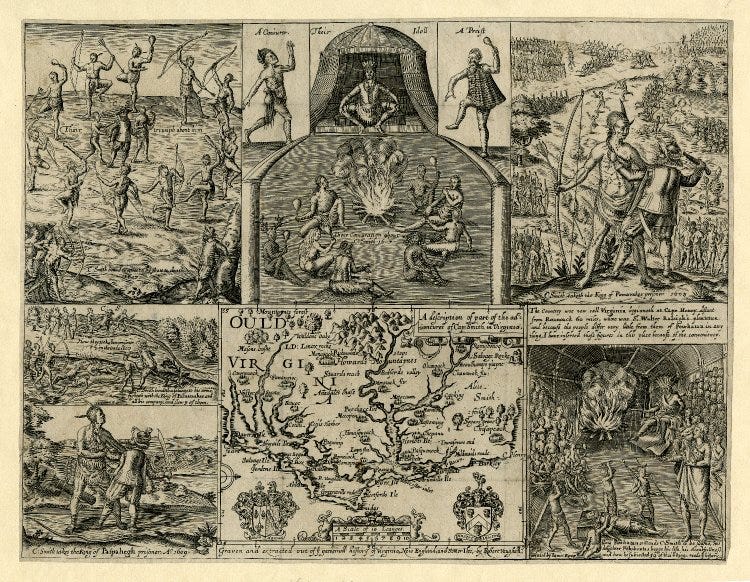
Great ideas, Kevin!
Thanks so much!
Terrapin. All the Deadheads of the world will be keeping the word alive. Terrapin Station, the 1977 9th studio LP, had a couple of my favorite Grateful Dead songs - Estimated Prophet and the epic title cut. And speaking of museums,
“”Terrapin Station” stands as a “place” in imagination, full of potential. It was the name given to the museum that was never built, meant to house the Dead’s archives and provide a performance and experience space.”
Kinda fits right in with what you are doing, Joel. I love reading your posts. I take about twice the estimated read time, but then, so much time and so little to do.